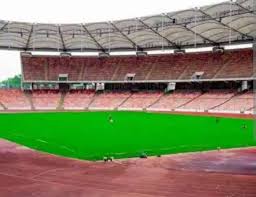What was once hailed as a triumph for Nigerian sports and a symbol of renewed hope has now become another somber reminder of the country’s recurring infrastructure woes. The Moshood Abiola National Stadium in Abuja, Nigeria’s flagship sporting complex, is facing yet another cycle of deterioration—barely years after a high-profile renovation funded by Africa’s richest man, Aliko Dangote.
In 2020, the Federal Government introduced the Adopt-A-Pitch initiative aimed at reviving key sporting facilities across the nation. As part of that effort, Dangote committed a $1 million (over N1 billion) investment toward revamping the main bowl of the iconic Abuja stadium. The plan promised world-class improvements: a new Pure Dynasty Paspalum turf—the same quality grass used at the 2022 FIFA World Cup in Qatar—digital scoreboards, an advanced sprinkler system consisting of 24 units, and nursery beds designed to ensure the long-term health of the pitch. Aron Nigeria Limited was contracted to manage maintenance for a minimum of two years.
For a moment, it seemed the tides had turned. The stadium’s pitch, once an eyesore, transformed into a lush green playing surface, drawing widespread praise. Ahead of Nigeria’s crucial 2022 World Cup qualifier against Ghana, football legend Daniel Amokachi boasted about the quality of the pitch, reflecting renewed pride in the country’s football infrastructure.
But the celebration was short-lived.
By mid-2022, barely a year after the refurbishment, signs of decay began to surface again. During a 2023 Africa Cup of Nations qualifier against Sierra Leone, the once-smooth playing surface was noticeably uneven. Players stumbled, passes went awry, and the risk of injury increased—culminating in complaints after Super Eagles defenders William Troost-Ekong and Ola Aina suffered knocks attributed to the poor condition of the pitch. Disappointed fans and pundits didn’t hold back, with many describing the surface as resembling a “potato farm.”
So, what happened?
Insiders point to neglect, mismanagement, and the absence of a sustainable usage model. Despite the investment and infrastructure upgrades, the two-year maintenance agreement collapsed prematurely. The nursery beds that were meant to support the pitch’s long-term health were left untouched, and the turf was left to wither under Abuja’s relentless heat. Infrequent use of the facility only compounded the problem. Without consistent events, matches, or community engagement, the stadium slowly slid back into abandonment.
This is not the first time the stadium has been caught in the loop of revival and relapse. Commissioned in 2003 during President Olusegun Obasanjo’s administration at a staggering cost of $360 million, the 60,491-capacity arena was intended to set a new benchmark for sports infrastructure in Africa. It dazzled at the 2003 All-Africa Games and hosted matches during the 2009 FIFA U-17 World Cup. But by the early 2010s, the once-pristine venue had become a shadow of itself—vandalized, unkempt, and stripped of international recognition.
Former Sports Minister Sunday Dare once warned that without a clear strategy for continuity, such investments would ultimately go to waste. His words now ring truer than ever. Sports analysts like Segun Odegbami also raised alarm about poor drainage systems and lack of technical maintenance expertise. Yet, recommendations were largely ignored, allowing neglect to fester.
Still, there appears to be a faint light at the end of the tunnel. With the re-establishment of the National Sports Commission (NSC) under the leadership of Mallam Shehu Dikko, fresh ideas are being floated to reposition sports infrastructure in the country. Dikko is pushing for a Public-Private Partnership (PPP) model, which would see stadiums developed into multi-purpose venues featuring hotels, restaurants, retail outlets, and entertainment hubs. The vision draws from successful templates like Tottenham Hotspur’s stadium in London—a facility designed not only for sport but as a year-round revenue-generating engine.
If implemented with diligence and transparency, such a model could rescue the MKO Abiola Stadium from its vicious cycle of decay and make it a true symbol of sporting excellence and economic viability in Nigeria. Until then, however, the stadium remains a case study in how lofty ambitions, without structured follow-through, can end in disappointment.
